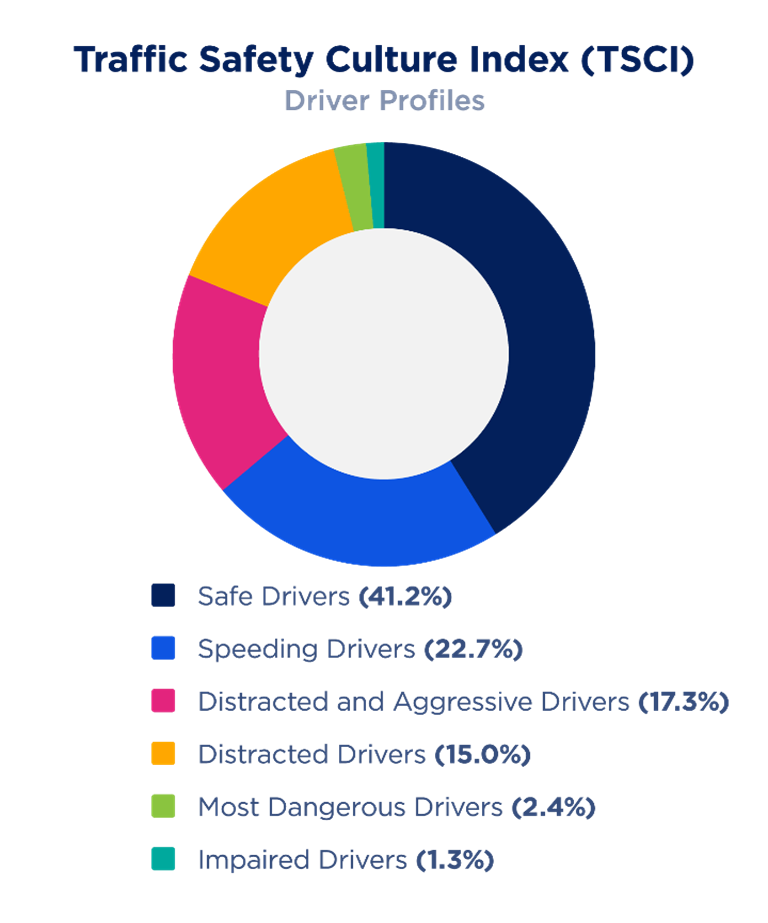BOISE – According to new research by the AAA Foundation for Traffic Safety, just 4 in 10 drivers surveyed nationwide reported good habits that classified them in the “Safe Drivers” category, while the majority admitted to regularly driving in ways that increase the risk of a serious crash.
Each year, the AAA Foundation’s Traffic Safety Culture Index studies driver attitudes about several dangerous behaviors and willingness to engage in them. New to this year’s research, AAA also categorized drivers based on their self-reported activities behind the wheel.

Nearly 25% of survey participants admitted to making decisions that put them in the “Speeding Drivers” category – a group of people who regularly drive 15 mph over the speed limit on freeways and/or 10 mph over on residential streets.
“Distracted and Aggressive Drivers,” who reported texting while driving, speeding, red-light running and switching lanes quickly, made up 17%, while “Distracted Drivers” who did not participate in other aggressive behavior made up 15%.
The ”Most Dangerous Drivers” category represents a small portion of the overall group, but they pose a serious risk to themselves and others by engaging in several risky driving behaviors on a regular basis.
“Thankfully, less than 5% of all survey respondents fell into the Most Dangerous Driver and Impaired Driver groups, but any kind of risky driving leads to slower reaction times and faster impact speeds. We can do more to prevent injury and loss of life,” says AAA Idaho public affairs director Matthew Conde. “Please work on breaking any bad driving habits this holiday season. One of the best gifts you can give this time of year is making sure everyone stays safe.” On average, members of the Distracted Driver, Distracted and Aggressive Driver, and Most Dangerous Driver categories were about 40 years of age – about 13 years younger than members of the other groups.
About 60% of both the Speeding Drivers and Most Dangerous Drivers were males, whereas 57% of the Safe Drivers were females.
“It’s possible that younger drivers with fewer family commitments and obligations have a different perspective on how risky their driving really is,” Conde said. “Regardless of your stage of life, please consider the consequences of your actions behind the wheel.”
Dangerous driving by the numbers
- Distracted driving – Roughly 93% of drivers view texting, emailing, and using a hand-held phone as very or extremely dangerous, yet 27% reported sending a text or email in the previous 30 days, and 38% reported holding and talking on a cell phone. According to the Idaho Transportation Department, distracted driving crashes made up 17% of all crashes on Idaho roads last year, and 16% of all traffic fatalities.
- Aggressive driving and speeding – About 83% of respondents said that driving through a red light was very or extremely dangerous, while 89% believed that switching lanes quickly and driving closely behind other vehicles was very or extremely dangerous.
About 63% of drivers believed that they would be caught if they drove 15 mph over the speed limit on a freeway, yet approximately half of them admitted doing so in the past 30 days before the survey. Aggressive driving was a contributing factor in 51% of Idaho crashes last year, with 81 fatalities and 600 serious injuries.
“Speeding isn’t as effective as we think it is,” Conde said. “You would have to drive 100 miles at 80 mph instead of 75 mph just to shave five minutes off your trip.”
- Drowsy driving – 95% of drivers view driving when they have a hard time keeping their eyes open to be very or extremely dangerous, but 18% reported doing so in the previous 30 days. Drowsy driving was a contributing factor in 5% of all single-vehicle crashes in Idaho, but because it can be difficult to determine after the fact, that number may be significantly understated.
- Impaired driving – 94% of survey respondents consider driving after drinking to be very or extremely dangerous, but 7% reported doing so in the previous 30 days. Only 85% expressed the same reservations about driving while using potentially impairing medications.
“Like alcohol, some medications have the ability to cause drowsiness, impair judgment, and slow reaction time,” Conde said. “Please ask your doctor and pharmacist how the medications you use may affect your driving, including how combinations of prescriptions may affect you.”
In 2022, 51% of all Idaho crash fatalities were the result of an impaired driving crash.
AAA regularly shares its findings with lawmakers, media and the driving public to improve safety on Idaho roads.

